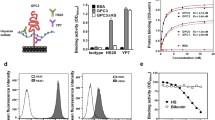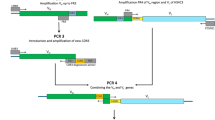Abstract
Background
The aim of this study was to screen and identify novel B cell epitopes within the human heparanase protein and to investigate the impact of self-developed anti-heparanase polypeptide antibodies on growth and invasion of HCCLM6 human hepatocellular carcinoma cells in vitro.
Methods
The flexible regions of secondary structure and the B cell epitopes of the human heparanase amino acid sequence were predicted by DNAStar and Bcepred software.The multiple antigenic peptides (MAP) of the epitopes were synthesized in eight-branched form. Rabbits were immunized with the eight-branched MAPs mixed with the universal T-helper epitope human IL-1β peptide (VQGEESNDK, amino acid 163–171). The immunogenicity of the synthesized peptides was evaluated by ELISA, western blot and immunohistochemistry. The impact of the self-developed rabbit anti-heparanase polyclonal antibodies on growth and invasion ability of HCCMLM6 cells were analyzed in a cell culture model. The cells were first treated with one of the three antibodies, respectively, and then measured by using MTT, flow cytometry, plate clone formation, invasion assay and heparan sulfate degrading enzyme assay.
Results
The three amino acid sequences 1–15 (MAP1), 279–293 (MAP2), and 175–189 (MAP3) in the large subunit of the human heparanase protein were predicted as its most potential epitopes. ELISA, western blot and immunohistochemistry analysis showed that all three MAPs were capable to induce high titer of serum antibodies. Antibodies induced by MAP1 and MAP2 were high specific. Furthermore, anti-MAP2 antibodies showed the strongest avidity towards liver cancer tissues. Under the treatment with the three anti-heparanase antibodies, respectively, the growth, cell cycle and clone formation of the cells remained unchanged when compared with a treatment with normal rabbit IgG. However, an inhibition of cell invasiveness and heparanase activity could be detected under the treatment with anti-MAP1- or anti-MAP2-antibody (with a terminal concentration of 100 μg/ml). The cell invasiveness was decreased by 54 and 38%, respectively, the heparanase activity by 43 and 39%, respectively.
Conclusion
The multiple antigenic peptides MAP1 (AC 1–15) and MAP2 (AC 279–293) may be the dominant B cell epitopes in the human heparanase protein. The induced polypeptide antibodies can effectively inhibit the heparanase activity of HCCLM6 liver cancer cells and therefore influence their invasion ability, which provides a theoretic basis for the development of anti-heparanase antibodies and their clinical use as vaccine.









Similar content being viewed by others
References
McKenzie EA (2007) Heparanase: a target for drug discovery in cancer and inflammation. Br J Pharmacol 151(1):1–14
Zhao H, Liu H, Chen Y et al (2006) Oligomannurarate sulfate, a novel heparanase inhibitor simultaneously targeting basic fibroblast growth factor, combats tumor angiogenesis and metastasis. Cancer Res 66(17):8779–8787
Miao HQ, Liu H, Navarro E et al (2006) Development of heparanase inhibitors for anti-cancer therapy. Curr Med Chem 13(18):2101–2111
Vlodavsky I, Ilan N, Naggi A et al (2007) Heparanase: structure, biological functions, and inhibition by heparin-derived mimetics of heparan sulfate. Curr Pharm Des 13(20):2057–2073
Vlodavsky I, Elkin M, Abboud JG et al (2008) Heparanase: one molecule with multiple functions in cancer progression. Connect Tissue Res 49(3):207–210
Ferro V, Dredge K, Liu LG et al (2007) PI-88 and novel heparin sulfate mimetics inhibit angiogenesis. Semin Thromb Hemost 33(5):557–568
Vlodavsky I, Goldshmidt O, Zcharia E et al (2002) Mammalian heparanase: involvement in cancer metastasis, angiogenesis and normal development. Semin Cancer Biol 12(2):121–129
Amexis G, Yong NS (2007) Multiple antigenic peptides as vaccine platform for the induction of humoral responses against dengue-2 virus. Viral Immunol 20(4):657–663
Haro I, Gómara MJ (2000) Different approaches to potentiate the immune response induced by a 12-mer synthetic peptide. Curr Protein Pept Sci 1(2):125–137
Dechamma HJ, Dighe V, Ashok KumarC et al (2006) Identification of T helper and linear B epitope in the hypervariable region of nucleocapsid protein of PPRV and its use in the development of specific antibodies to detect viral antigen. Vet Microbiol 118(3–4):201–211
Li Y, Tian B, Yang J et al (2004) Stepwise metastatic human hepatocellular carcinoma cell model system with multiple metastatic potentials established through consecutive in vivo selection and studies on metastatic characteristics. J Cancer Res Clin Oncol 130(8):460–468
Wang SM, Zhu J, Pan LF et al (2008) Inhibitory effect of dimeric beta peptide on the recurrence and metastasis of hepatocellular carcinoma in vitro and in mice. World J Gastroenterol 14(19):3054–3058
Yang JM, Peng ZH, Si SH et al (2008) KAI1 gene suppresses invasion and metastasis of hepatocellular carcinoma MHCC97-H cells in vitro and in animal models. Liver Int 28(1):132–139
Pietersz GA, Pouniotis DS, Apostolopoulos V et al (2006) Design of peptide-based vaccines for cancer. Curr Med Chem 12(13):1591–1607
Bueter M, Gasser M, Lebedeva T et al (2006) Influence of p53 on anti-tumor immunity. Int J Oncol 28(2):519–525
Wu X, Bundle DR (2005) Synthesis of glycoconjugate vaccine for Candica albicans using novel linker methodology. J Org Chem 70(18):7381–7388
Pau CP, Luo W, McDougal JS (2007) Chimeric multiple antigenic peptides for simultaneous detection of specific antibodies to HIV-1 groups M, N, O, and HIV-2. J Immunol Methods 318(1–2):59–64
Haro I, Gomara MJ (2004) Design of synthetic peptidic constructs for the vaccine development against viral infections. Curr Protein Sci 5(6):425–433
Zhou Z, Bates M, Madura JD (2006) Structure modeling, ligand binding, and binding affinity calculation (LR-MM-PBSA) of human heparanase for inhibition and drug design. Protein 65(3):580–592
Zetser A, Levy-Adsm F, Kaplan V et al (2004) Processing and activation of latent heparanase occurs in lysosomes. J Cell Sci 117(Pt 11):2249–2258
Levy-Adam F, Abboud-Jarrous G, Guerrini M et al (2005) Identification and characterization of heparin/heparan sulfate binding domains of the endoglycosidase heparanase. J Biol Chem 280(21):20457–20466
Dempsey LA, Plummer TB, Coombes SL et al (2000) Heparanase expression in invasive trophoblasts and acute vascular damage. Glycobiology 10(5):467–475
Ilan N, Elkin M, Vlodavsky I (2006) Regulation, function and clinical significance of heparanase in cancer metastasis and angiogenesis. Int J Biochem Cell Biol 38(12):2018–2039
He X, Brenchley PE, Jayson GC et al (2004) Hypoxia increases heparanase-dependent tumor cell invasion, which can be inhibited by antiheparanase antibodies. Cancer Res 64(11):3928–3933
Gingis-Velitski S, Ishai-Michaeli R, Vlodavsky I et al (2007) Anti-heparanase monoclonal antibody enhances heparanase enzymatic activity and facilitates wound healing. FASEB J 21(14):3986–3993
Acknowledgments
This project was supported by grant No. 30570816 from National Natural Science Foundation of China.
Author information
Authors and Affiliations
Corresponding author
Rights and permissions
About this article
Cite this article
Yang, Jm., Wang, Hj., Du, L. et al. Screening and identification of novel B cell epitopes in human heparanase and their anti-invasion property for hepatocellular carcinoma. Cancer Immunol Immunother 58, 1387–1396 (2009). https://doi.org/10.1007/s00262-008-0651-x
Received:
Revised:
Accepted:
Published:
Issue Date:
DOI: https://doi.org/10.1007/s00262-008-0651-x




